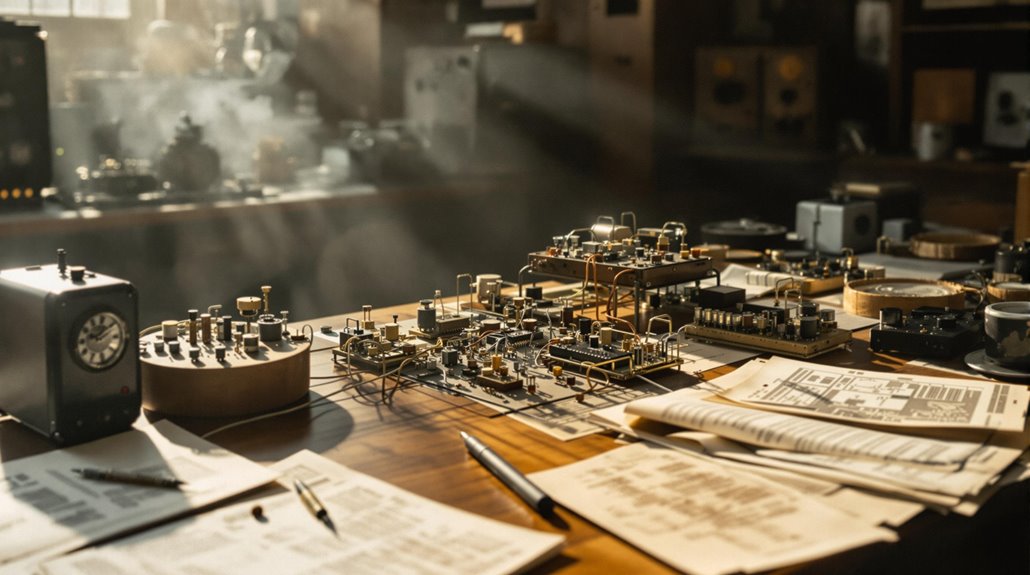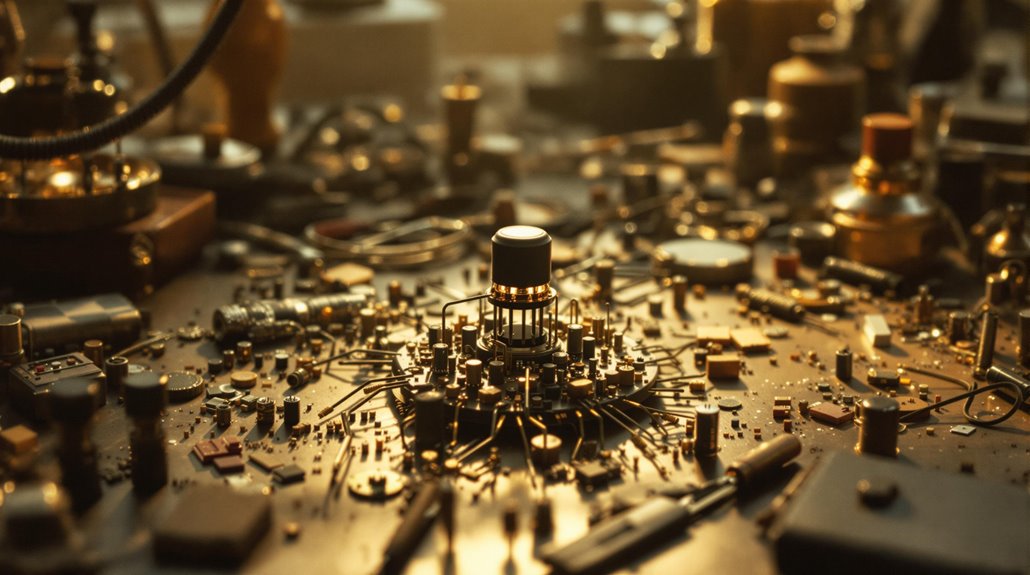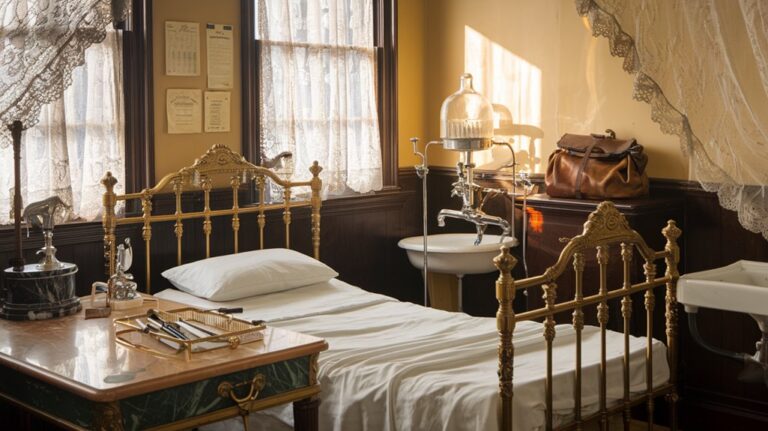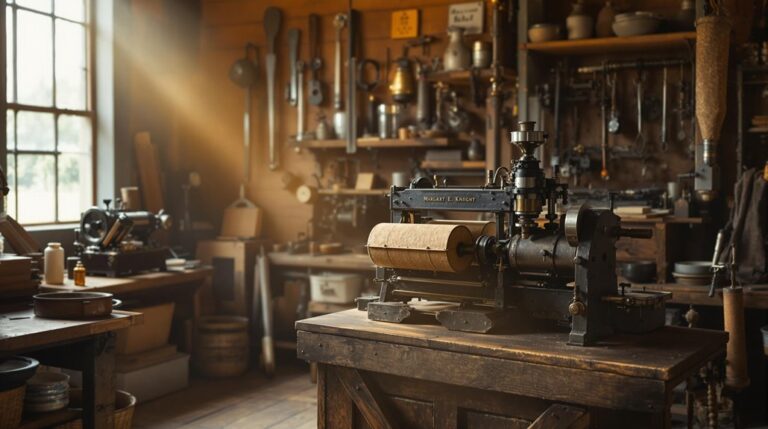William Shockley’s Transistor Tiff: The Day Bell Labs Imploded Over Credit
You've probably heard about the transistor's world-changing impact, but you might not know about the drama that nearly derailed its development. When William Shockley returned from a business trip in December 1947, he discovered his Bell Labs colleagues had achieved what he'd been chasing: a working transistor. What happened next would shake the foundations of one of America's premier research institutions and transform a scientific triumph into a cautionary tale of ego, ambition, and betrayal.
The Golden Years at Bell Labs: Leading the Solid State Revolution
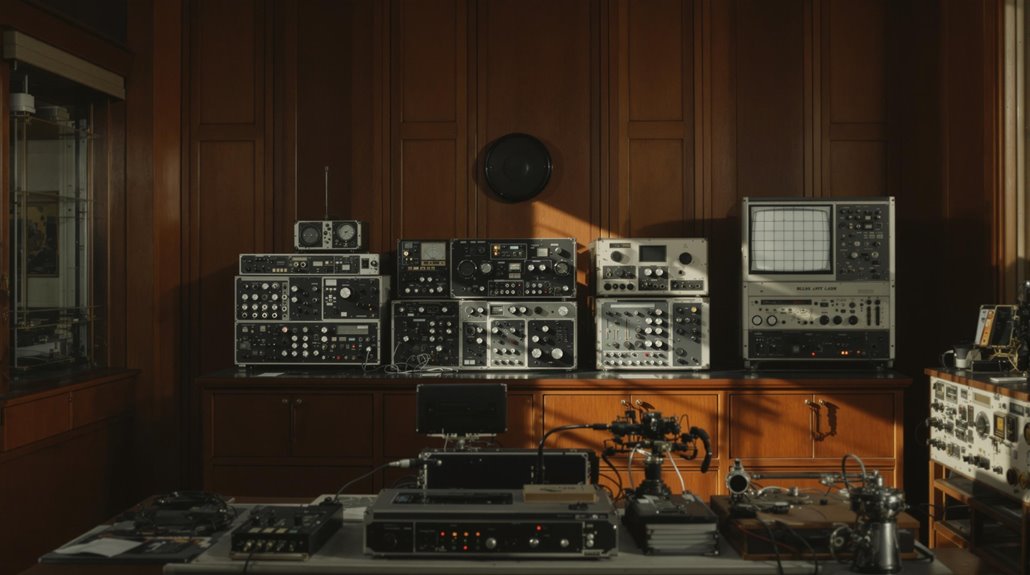
While vacuum tubes dominated electronics in the 1930s, Bell Labs' new research director Mervin Kelly had a bold vision for the future. He knew solid state innovations would revolutionize telecommunications, so he began recruiting brilliant physicists like William Shockley to tackle this challenge.
You'll find that Bell Labs' collaborative dynamics shifted dramatically as Shockley joined in 1936 and immediately dove into semiconductor research. He teamed up with Walter Brattain to develop new amplifier designs using copper-oxide materials. Their work established solid-state device development that would eventually replace vacuum tubes.
Though their 1939 prototype failed, this setback didn't deter their progress. After World War II, Shockley led a dedicated solid-state research group, bringing together minds like John Bardeen. Their groundbreaking work would eventually lead to the invention of the point-contact transistor in December 1947.
Despite facing complex challenges in understanding electron behavior and material composition, their persistence would soon change electronics forever.
A Breakthrough Without Its Leader: December 1947
Although William Shockley led Bell Labs' semiconductor research, he wasn't present for his team's historic breakthrough in December 1947.
While he was away, John Bardeen and Walter Brattain achieved a remarkable feat: creating the first working transistor using germanium and gold contacts in a point-contact design.
The device was officially named the transistor by Pierce, becoming the term we still use today.
The innovation challenges of developing a semiconductor amplifier were finally overcome when the device successfully amplified signals up to 100 times.
The team dynamics shifted dramatically after the December 23rd demonstration to Bell Labs officials.
Shockley, feeling excluded from this momentous discovery within his own department, responded by quickly developing a competing junction transistor design.
His push to be recognized as the sole inventor in patent applications strained his relationships with Bardeen and Brattain, marking the beginning of a bitter dispute over credit for the invention.
As a graduate of Cal Tech physics, Shockley had the theoretical background necessary to understand the implications of the breakthrough.
The Battle for Recognition: Shockley's Quest for Credit
Upon learning of his team's breakthrough, Shockley launched an aggressive campaign for recognition at Bell Labs. His demand for joint credit on the transistor patent sparked intense collaborative tensions, leading to deepening rifts between him and his colleagues, Bardeen and Brattain.
The prior patent discovery from Julius Lilienfeld would ultimately undermine Shockley's claims.
Here's how the credit disputes escalated:
- Shockley insisted on being recognized as a co-equal inventor.
- Bell Labs arranged a publicity photo with him in the foreground.
- Bardeen and Brattain threatened to quit rather than work under him.
- The patent battle continued to simmer for decades.
While Bell Labs tried to appease Shockley with a second patent application and public recognition, the damage was done. The sandwich transistor design he developed shortly after would prove more commercially viable than the point-contact version.
The once-promising collaboration crumbled, eventually leading to Shockley's departure in 1955 to establish his ill-fated semiconductor company.
Birth of the Junction Transistor: A Solo Mission
Frustration from the point-contact patent dispute sparked Shockley's determination to create something entirely his own.
You can trace this transistor evolution to January 23, 1948, when he conceived the junction transistor idea, building upon Russell Ohl's p-n junction discovery.
His detailed findings were recorded in Bell Labs Notebook 20455, documenting his revolutionary concepts.
His semiconductor innovation gained momentum when John Shive's February experiment proved that holes could flow through bulk germanium, validating Shockley's minority carrier injection theory.
By June 1948, he'd filed for the patent, and in 1949, he published his groundbreaking theory of p-n junctions.
The practical breakthrough came when Gordon Teal and Morgan Sparks transformed Shockley's vision into reality, creating the first grown-junction transistors in 1951.
On July 4th that year, Bell Labs disclosed this achievement, marking Shockley's vindication in his solo pursuit.
Shockley would later establish Shockley Semiconductor Laboratory in 1955, taking his expertise and innovative drive to what would become Silicon Valley.
The Great Divide: How Success Tore the Team Apart
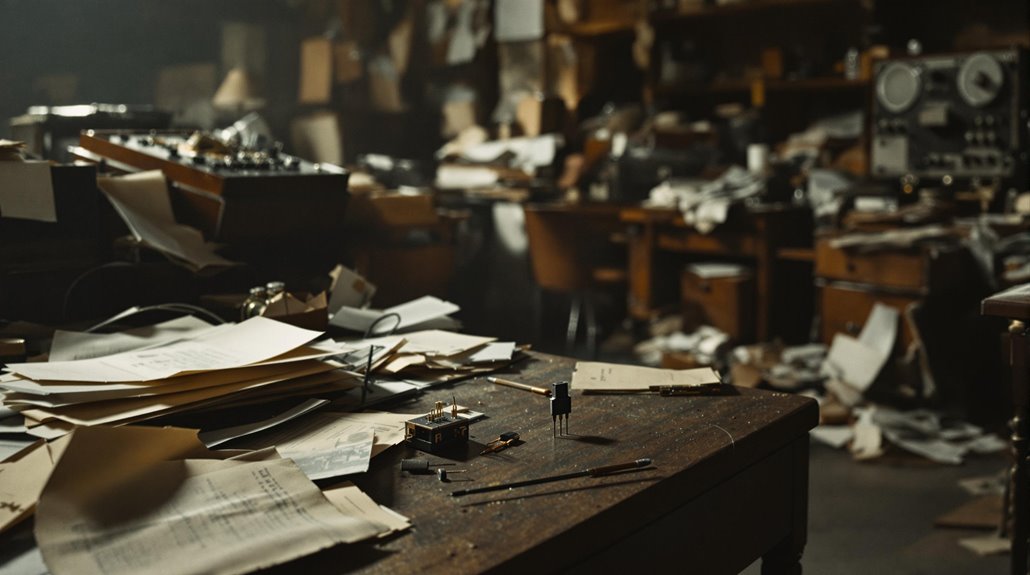
When Bardeen and Brattain's point-contact transistor success made headlines, Shockley's complex reaction set off a chain of events that would fracture the team.
Despite being proud of the achievement, he couldn't hide his fury at their success where he'd failed. The ensuing credit disputes created an irreparable rift in team dynamics.
Bell Labs tried to manage the situation by:
 Bell Laboratories' first transistor had taken place at their Murray Hill facility in New Jersey.
Bell Laboratories' first transistor had taken place at their Murray Hill facility in New Jersey.

